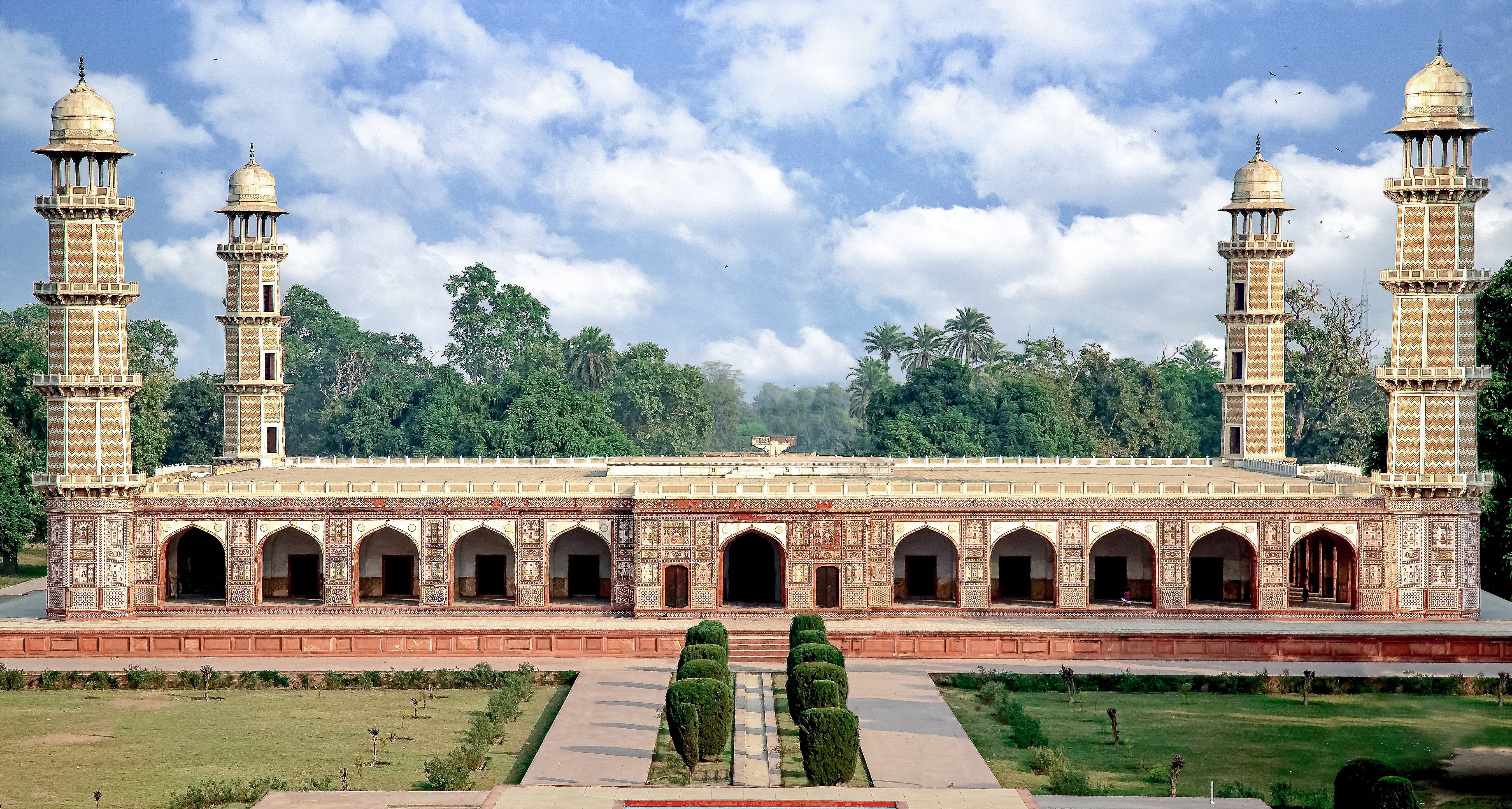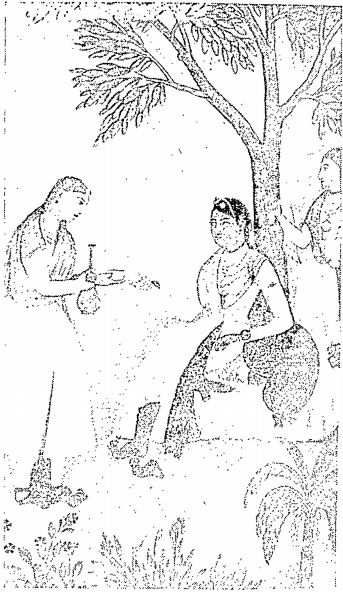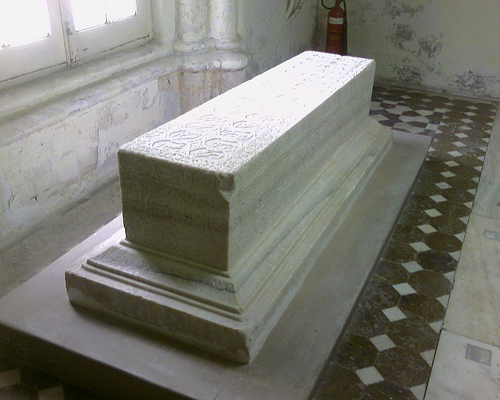|
Jehangir
Nur-ud-Din Muhammad Salim (30 August 1569 – 28 October 1627), known by his imperial name Jahangir (; ), was the fourth Mughal Emperor, who ruled from 1605 until he died in 1627. He was named after the Indian Sufi saint, Salim Chishti. Early life Prince Salim was the third son born to Akbar and his favourite Queen Consort, Mariam-uz-Zamani in Fatehpur Sikri on 30 August 1569. He had two elder brothers, Hassan Mirza and Hussain Mirza, born as twins to his parents in 1564, both of whom died in infancy. Since these children had died in infancy, Akbar sought the blessing of holy men for an heir-apparent to his empire. When Akbar was informed of the news that his chief Hindu wife was expecting a child, an order was passed for the establishment of a royal palace in Sikri near the lodgings of Shaikh Salim Chisti, where the Empress could enjoy the repose being in the vicinity of the revered saint. Mariam was shifted to the palace established there and during her pregnancy, Akb ... [...More Info...] [...Related Items...] OR: [Wikipedia] [Google] [Baidu] |
Tomb Of Jahangir
The Tomb of Jahangir ( ur, ) is a 17th-century mausoleum built for the Mughal Emperor Jahangir. The mausoleum dates from 1637, and is located in Shahdara Bagh near city of Lahore, Pakistan, along the banks of the Ravi River. The site is famous for its interiors that are extensively embellished with frescoes and marble, and its exterior that is richly decorated with ''pietra dura''. The tomb, along with the adjacent Akbari Sarai and the Tomb of Asif Khan, are part of an ensemble currently on the tentative list for UNESCO World Heritage status. Location The tomb is located in Shahdara Bagh, northwest of the Walled City of Lahore. The tomb is located across the River Ravi from Lahore, in what was a rural area known for its numerous pleasure gardens. The tomb is located in Jahangir's pleasure garden, the ''Dilkusha'' Garden, which had been laid out in 1557. The Tomb of Asif Khan, built-in 1645, and the Akbari Sarai, built-in 1637, are located immediately west of Jahangir's tomb co ... [...More Info...] [...Related Items...] OR: [Wikipedia] [Google] [Baidu] |
Lahore
Lahore ( ; pnb, ; ur, ) is the second most populous city in Pakistan after Karachi and 26th most populous city in the world, with a population of over 13 million. It is the capital of the province of Punjab where it is the largest city. Lahore is one of Pakistan's major industrial and economic hubs, with an estimated GDP ( PPP) of $84 billion as of 2019. It is the largest city as well as the historic capital and cultural centre of the wider Punjab region,Lahore Cantonment globalsecurity.org and is one of Pakistan's most socially liberal, |
Fatehpur Sikri
Fatehpur Sikri () is a town in the Agra District of Uttar Pradesh, India. Situated 35.7 kilometres from the district headquarters of Agra, Fatehpur Sikri itself was founded as the capital of Mughal Empire in 1571 by Emperor Akbar, serving this role from 1571 to 1585, when Akbar abandoned it due to a campaign in Punjab and was later completely abandoned in 1610. The name of the city is derived from the village called ''Sikri'' which occupied the spot before. An Archaeological Survey of India (ASI) excavation from 1999 to 2000 indicated that there was a habitation, temples and commercial centres here before Akbar built his capital. The region was settled by Sungas following their expansion. It was controlled by Sikarwar Rajputs from the 7th to 16th century CE until the Battle of Khanwa (1527). The '' khanqah'' of Sheikh Salim Chishti existed earlier at this place. Akbar's son Jahangir was born in the village of Sikri to his favourite wife Mariam-uz-Zamani in 1569 and in ... [...More Info...] [...Related Items...] OR: [Wikipedia] [Google] [Baidu] |
Jagat Gosain
Manavati Bai, also spelled Manvati Bai, (13 May 1573 – 8 April 1619), better known by her title, Jagat Gosain (), was the second wife and the empress consort of the fourth Mughal emperor Jahangir and the mother of his successor, Shah Jahan. She is also known as Mani Bai, Manmati, Jodh Bai (), Findly, p. 396 Taj Bibi () and was also given the posthumous title of Bilqis Makani (). She was also wrongly referred to as Balmati Begum by Manrique. She should not be confused with her mother-in-law, Mariam-uz-Zamani, who was erroneously called as "Jodha Bai" by European historians since any daughter belonging to the Jodhpur region could be called Jodha Bai or daughter of Jodhpur region. By birth, she was a Rajput princess of Marwar (present-day Jodhpur) and was the daughter of Raja Udai Singh (popularly known as ''Mota Raja''), the Rathore ruler of Marwar and the full-sister of Sawai Raja Sur Singh, another Rathore ruler of Marwar and Maharaja Kishan Singh, founder of Kishanga ... [...More Info...] [...Related Items...] OR: [Wikipedia] [Google] [Baidu] |
Saliha Banu Begum
Saliha Banu Begum (died 10 June 1620) was Empress consort of the Mughal Empire as the wife of Emperor Jahangir. She was also known as the Padshah Banu Begum or the Padshah Mahal. Family Saliha Banu Begum was the daughter of Qaim Khan, and came from a well placed family in the government as her brother, Abdur Rahim (titled Tarbiyat Khan), was said by Jahangir to be "of the hereditary houseborn ones of this Court." She was the granddaughter of Muqim Khan, the son of Shuja'at Khan from Akbar's time. Marriage Jahangir married her in 1608, in the third year of his reign. As a consequence, her brother Abdur Rahim's position greatly advanced. He was awarded with the title of Tarbiyat Khan. His son named Miyan Joh, whom Saliha had taken for her son, was killed at the banks of river Jhelum by Mahabat Khan when the latter behaved insolently towards Jahangir, in 1626. For much of Jahangir's reign, she was the Padishah Banu ("The Sovereign Lady"), also called Padishah Mahal ("Sovereign of t ... [...More Info...] [...Related Items...] OR: [Wikipedia] [Google] [Baidu] |
Nur Jahan
Nur Jahan, born Mehr-un-Nissa P ersian: نورجهان (; – 18 December 1645) was the wife and chief consort of the Mughal emperor Jahangir from 1620 until his death in 1627. Nur Jahan was born Mehr-un-Nissa, as the daughter of a Mirza Ghiyas Beg, who served under Jahangir's father, Emperor Akbar. Nur Jahan was the most powerful empress in the Mughal Empire. More decisive and proactive than her husband, she is considered by historians to have been the real power behind the throne for more than a decade. Nur Jahan was granted certain honours and privileges which were never enjoyed by any Mughal empress before or after like having coinage struck in her name. Jahangir's addiction to alcohol and opium made it easier for Nur Jahan to exert her influence over him and exercise power. She was granted the privilege to issue farmāns (sovereign mandates). The only other empress to command such devotion from her husband was Mumtaz Mahal, for whom the Taj Mahal was built by Emperor S ... [...More Info...] [...Related Items...] OR: [Wikipedia] [Google] [Baidu] |
Sahib Jamal
Sahib Jamal ( fa, صاحب جمال; died 25 June 1599) was the wife of Prince Salim, the future Mughal emperor Jahangir and the mother of his second son, Prince Parviz. Family Sahib Jamal was of Turkish origin and was the daughter of a respected Muslim religious personality, Khwaja Hasan of Herat, making her the cousin of Zain Khan Koka, who was a leading official in the Mugal Empire under Akbar, including serving for a time as governor of Kabul. Her father, Khwaja Hasan, was known widely for his scholarship and studies in the techniques of warfare. Akbar held him in high esteem, and often discussed with him the spiritual problems that often agitated his mind. Zain Khan's daughter, Khas Mahal was also married to Jahangir. Sahib Jamal was a beautiful, highly cultured and well educated woman, who was fully conversant with the rules and etiquettes of the palace. Marriage Salim married her on 1586. Upon her marriage, she was given the title "Sahib Jamal", which literally me ... [...More Info...] [...Related Items...] OR: [Wikipedia] [Google] [Baidu] |
Malika Jahan
Malika Jahan ( fa, ملکہ جھان; meaning "Queen of the World") was a Jaisalmer princess, and wife of Mughal emperor Jahangir. Family Malika Jahan, whose Rajput name is unknown, was born a Jaisalmer princess, the daughter of Rawal Bhim Singh, the ruler of Jaisalmer, and a contemporary of Emperor Akbar, and in imperial service to him. He had been a man of rank and influence. She was the granddaughter of Rawal Harraj. She had three paternal uncles named Kalyan Mal, Bhakar and Sultan. Her aunt was married to Emperor Akbar Abu'l-Fath Jalal-ud-din Muhammad Akbar (25 October 1542 – 27 October 1605), popularly known as Akbar the Great ( fa, ), and also as Akbar I (), was the third Mughal emperor, who reigned from 1556 to 1605. Akbar succeeded his father, Hum ... in 1570, and was a mother of a daughter named Mahi Begum. Rawal Bhim succeeded his father Harraj in 1578. After Bhim's death in 1616, he left a son named Nathu Singh, two months old, who was killed by the Bhat ... [...More Info...] [...Related Items...] OR: [Wikipedia] [Google] [Baidu] |
Padshah
Padishah ( fa, پادشاه; ; from Persian: Old_Persian.html" ;"title="r Old Persian">r Old Persian: * 'master', and ''shāh'', 'king'), sometimes Romanization of Persian, romanised as padeshah or padshah ( fa, پادشاه; ota, پادشاه, pādişah; tr, padişah, ; ur, , hi, बादशाह, baadashaah), is a superlative sovereign title of Persian origin. A form of the word is known already from Middle Persian, or Pahlavi language, as ''pātaxšā(h)'' or ''pādixšā(y)''. Middle Persian ''pād'' may stem from Avestan ''paiti'', and is akin to Pati (title). ''Xšāy'', "to rule", and ''xšāyaθiya,'' "king", are from Old Persian. It was adopted by several monarchs claiming the highest rank, roughly equivalent to the ancient Persian notion of " Great King", and later adopted by post-Achaemenid and the Mughal emperors of India. However, in some periods it was used more generally for autonomous Muslim rulers, as in the '' Hudud al-'Alam'' of the 10th century, ... [...More Info...] [...Related Items...] OR: [Wikipedia] [Google] [Baidu] |
Nur-un-Nissa Begum (wife Of Jahangir)
Nur-un-Nissa Begum ( fa, نورالنساء بیگم; born 1570) meaning 'Light among Women', was a Timurid princess, the daughter of Ibrahim Husain Mirza and the wife of fourth Mughal emperor Jahangir. Early life Born a Timurid princess, Nur-un-Nissa Begum was the daughter of Prince Ibrahim Husain Mirza, a descendant of Prince Umar Shaikh Mirza, second son of Amir Timur. Her mother was Princess Gulrukh Begum, the daughter of Prince Kamran Mirza, son of the first Mughal emperor Babur, and brother of the next emperor Humayun. She had a brother named Prince Muzaffar Husain Mirza, married to Akbar's eldest daughter Khanum Sultan Begum. In 1572, Gulrukh Begum lost contact with her husband Ibrahim Husain Mirza as he was forced to vacate Gujarat by Akbar. She fled to the Deccan with her children. Ibrahim Husain Mirza, who ultimately fled towards Multan, was captured by the royal officers. In 1573, he died while still in prison. On their way to Deccan, the ruler of Khandesh attempted ... [...More Info...] [...Related Items...] OR: [Wikipedia] [Google] [Baidu] |
Marriages
Marriage, also called matrimony or wedlock, is a culturally and often legally recognized union between people called spouses. It establishes rights and obligations between them, as well as between them and their children, and between them and their in-laws. It is considered a cultural universal, but the definition of marriage varies between cultures and religions, and over time. Typically, it is an institution in which interpersonal relationships, usually sexual, are acknowledged or sanctioned. In some cultures, marriage is recommended or considered to be compulsory before pursuing any sexual activity. A marriage ceremony is called a wedding. Individuals may marry for several reasons, including legal, social, libidinal, emotional, financial, spiritual, and religious purposes. Whom they marry may be influenced by gender, socially determined rules of incest, prescriptive marriage rules, parental choice, and individual desire. In some areas of the world, arranged ma ... [...More Info...] [...Related Items...] OR: [Wikipedia] [Google] [Baidu] |
Sultan-un-Nissa Begum
Sultan-un-Nissa Begum (25 April 1586 – 5 September 1646) was a Mughal princess, the eldest child and first daughter of Mughal Emperor Jahangir from his first wife, Shah Begum. Life Sultan-un-Nissa, also known as Nithar Begum, was born on 25 April 1586, Kashmir during the reign of her grandfather, Akbar on the intended return journey of the Imperial household towards Fatehpur Sikri. Her father was the eldest surviving son of Akbar, Prince Salim and her mother was Shah Begum, popularly known as Man Bai, the daughter of Bhagwant Das, the Raja of Amer. On the occasion of her birth, the Emperor assembled a great feast at the house of the Queen Mother, Mariam Makani where large amount of gifts were exchanged. Her only full sibling was the ill-fated Khusrau Mirza Khusrau Mirza (16 August 1587 – 26 January 1622) was the eldest son of the Mughal Emperor Jahangir and his first wife, Shah Begum. He was beloved of his grandfather, Mughal Emperor Akbar and his grandmother, ... [...More Info...] [...Related Items...] OR: [Wikipedia] [Google] [Baidu] |







